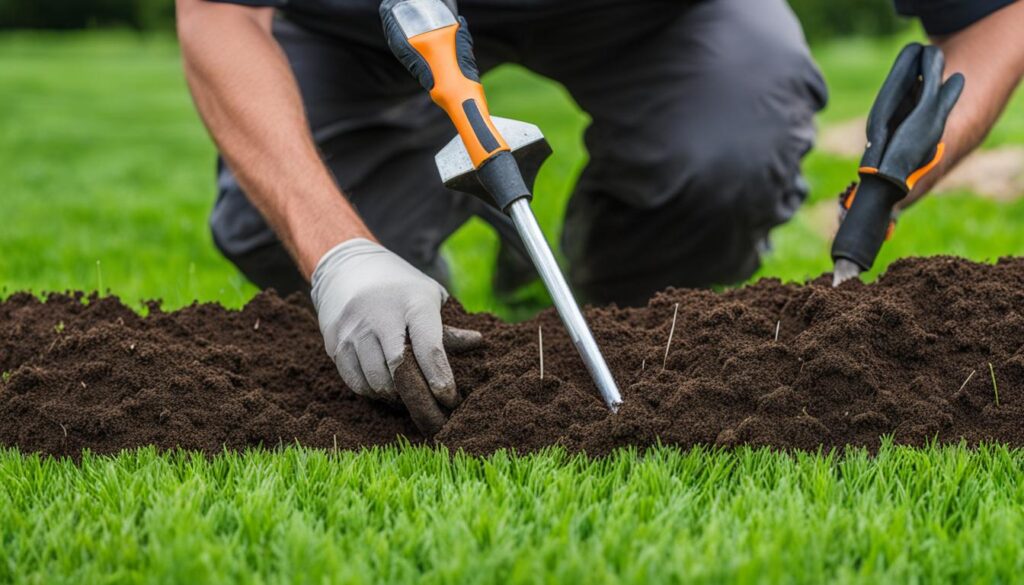Are you looking for an effective way to improve the health and appearance of your lawn? Look no further. Hand lawn aeration is a simple and impactful technique that can transform your turf into a lush and vibrant oasis.
Unlike mechanical aerators, hand aeration allows you to have complete control over the process and establish a stronger connection with your lawn. By physically engaging with your soil, you can enhance its vitality and encourage optimal growth.
In this comprehensive guide, we will walk you through the step-by-step process of hand lawn aeration. From gathering the necessary tools to post-aeration care, we will provide you with expert tips and insights to ensure your success.
So, if you’re ready to unlock the full potential of your lawn and achieve a healthy and flourishing turf, let’s dive into the world of hand lawn aeration.
Tools and Materials Needed for Hand Aeration
Before you begin hand aerating your lawn, gather the necessary tools and materials. These include a lawn aerator, such as a manual spike aerator or core aerator, a lawnmower to trim the grass, a garden hose and sprinkler to water the lawn, and markers to indicate any potential obstacles. These tools and materials will ensure that you are well-equipped for the aeration process.
Evaluate your Lawn’s Specific Needs
Before starting the aeration process, it is important to evaluate your lawn’s specific needs. Consider the grass type you have, as different grass types may have varying aeration requirements. Determine the soil type of your lawn, as this will influence the frequency of aeration needed. Take into account your lawn habits, such as foot traffic and recent grass seed applications. Lastly, check the depth of the roots to determine if aeration is necessary.
Choose the Type of Aeration Method
When it comes to hand lawn aeration, there are several methods to choose from. Each method offers its own unique benefits and is suitable for different lawn sizes and conditions. To select the most appropriate method for your lawn, consider the following options:
Manual Core Aerator
If your lawn has compacted soil or heavy thatch buildup, a manual core aerator is the ideal choice. This tool removes small cylindrical plugs of soil, allowing for better water and nutrient penetration. By creating channels for air and moisture, the manual core aerator promotes healthier root growth and overall lawn vitality.
Manual Spike Aerator
If you have a smaller lawn or need to target specific problem areas, the manual spike aerator is a great option. This tool features sharp spikes that penetrate the soil, creating small holes for air, water, and nutrients to reach the root zone. The manual spike aerator is easy to use and provides effective aeration for maintaining a healthy lawn.
Garden Fork
A garden fork can be a practical alternative to traditional hand aerators, especially for small lawns or hard-to-reach areas. Simply press the tines of the fork into the soil, creating airflow channels. Although it requires more effort and is less efficient, the garden fork can still help improve soil compaction and promote better grass growth.
Aerator Shoes
If you prefer a more hands-on approach to aerating your lawn, consider using aerator shoes. These adjustable shoes feature built-in metal spikes that create small holes as you walk across the lawn. While not as effective as manual aerators, aerator shoes provide a convenient option for light aeration and can be easily used as part of your regular lawn care routine.
Take a moment to assess your lawn’s specific needs and choose the aeration method that best suits your requirements. Whether you opt for a manual core aerator, manual spike aerator, garden fork, or aerator shoes, each method can contribute to the health and beauty of your lawn.
Prepare Your Lawn for Aeration
Proper preparation is essential for successful hand lawn aeration. To ensure optimal results, follow these important steps.
Mow Your Lawn
Begin by mowing your lawn to the appropriate height. This will not only improve the overall appearance of your lawn but also ensure that the grass is trimmed enough for effective aeration.
Tip: Set your lawnmower to the recommended cutting height for your specific grass type.
Water the Lawn
Watering your lawn a day or two before aeration can help soften the soil, making it easier to penetrate. Ensure that the soil is moist, but not excessively wet, before you begin the aeration process.
Tip: Consider using a sprinkler system or a garden hose to evenly distribute water across your lawn.
Mark Potential Obstacles
Prior to aeration, take the time to identify and mark any potential obstacles in your lawn. This can include sprinkler heads, utility lines, or any other items that could be damaged during the process. Using markers to clearly indicate their locations will help you avoid any accidents.
Tip: Use brightly colored flags or stakes to mark these obstacles for easy visibility.
By diligently preparing your lawn, you’ll be setting the stage for successful hand lawn aeration. Now that your lawn is ready, let’s move on to the aeration process itself.
Aerate Your Lawn
The process of hand lawn aeration involves inserting the aerator into the soil in a systematic pattern. Applying steady pressure as you walk and overlapping each pass ensures thorough coverage and optimal results.
First, start by inserting the aerator into the soil at a predetermined depth. Position the aerator in a way that allows it to penetrate the soil easily without causing excessive strain. Remember to follow the manufacturer’s instructions for your specific aerator model, as they may vary.
Next, walk in a systematic pattern across your lawn, ensuring that you cover the entire area evenly. This pattern helps prevent missing spots and ensures that each area receives equal aeration. You can use markers or flags to guide your path and maintain a consistent pattern.
As you walk, apply steady pressure to the aerator to ensure it penetrates the soil effectively. This pressure helps create holes or remove soil cores, promoting better airflow, water absorption, and root development.
Depending on the type of aerator used, you may notice soil cores accumulating on the lawn’s surface. These soil cores, also known as plugs, are an essential byproduct of aeration and should be left on the lawn. Over time, they will break down and provide valuable nutrients to the soil, contributing to overall lawn health.
Post-Aeration Care
After completing the aeration process, it is time to give your lawn the post-aeration care it needs to thrive. This stage is crucial for maintaining the health and vitality of your lawn. By following these tips, you can ensure that the benefits of aeration are maximized and your lawn remains lush and green.
Fertilize Your Lawn
Fertilizing your lawn is an essential step in post-aeration care. It helps promote healthy grass growth and provides the necessary nutrients for your lawn to thrive. Consider using organic compost, sand, or peat moss as natural fertilizers. Apply these fertilizers evenly across your lawn, following the recommended application rates. This will give your grass the nutrients it needs to recover quickly and develop strong roots.
Water Consistently
Proper watering is crucial after aeration to maintain soil moisture and aid in grass recovery. Water your lawn deeply, allowing the water to penetrate the soil to a depth of 6-8 inches. This encourages deep root growth and helps establish a healthy and resilient lawn. Depending on the weather and soil conditions, you may need to water your lawn 2-3 times a week. Monitor the moisture levels and adjust the frequency and duration of watering accordingly.
Stick to Lawn Care Practices
Continuing with regular lawn care practices is vital for the long-term health of your lawn. Mow your lawn at the appropriate height, removing no more than one-third of the grass blade at a time. This ensures optimal photosynthesis and reduces stress on the grass. Remember to take care when mowing over any remaining soil cores from aeration.
In addition to mowing, continue fertilizing your lawn on a regular schedule following the recommended application rates. This provides a steady supply of nutrients to support ongoing growth and development. Keep an eye out for any signs of weed growth and treat them promptly to avoid competition for resources.
In conclusion, post-aeration care plays a crucial role in maintaining a healthy, vibrant lawn. By fertilizing your lawn, watering consistently, and sticking to regular lawn care practices, you can ensure that your lawn remains strong and resilient. Follow these simple steps, and you’ll enjoy the rewards of a lush and beautiful lawn year-round.
Can Aeration Help Prevent Flooding in the Yard?
Aeration is one of the best tips for preventing backyard floods. By loosening the soil and allowing better water absorption, aeration can help prevent water pooling and flooding in the yard. This simple technique can make a big difference in protecting your yard from flooding during heavy rains.
Conclusion
Hand lawn aeration offers numerous benefits for your lawn’s health and vitality. By taking the time to aerate your lawn by hand, you can achieve exceptional results and ensure the long-term well-being of your turf. Remember to consider your lawn’s specific needs, choose the right tools and materials, and provide post-aeration care.
A key benefit of hand aeration is the control and connection it provides with your lawn. By manually inserting the aerator into the soil, you can target problem areas and focus on areas that need extra attention. This hands-on approach allows you to understand your lawn better and make informed decisions to promote its health.
Incorporating regular hand aeration into your lawn maintenance routine is essential for a lush and vibrant lawn. Aeration helps eliminate compacted soil, improve water and nutrient absorption, and promote deeper root growth. As a result, your lawn becomes more resilient to stress factors such as heat, drought, and disease.
To maintain the benefits of hand aeration, it is important to continue implementing proper lawn care practices. Fertilize your lawn regularly, water deeply but infrequently, and mow at the correct height for your grass type. By combining these maintenance tips with regular hand aeration, you can enjoy a beautiful, healthy lawn year-round.











